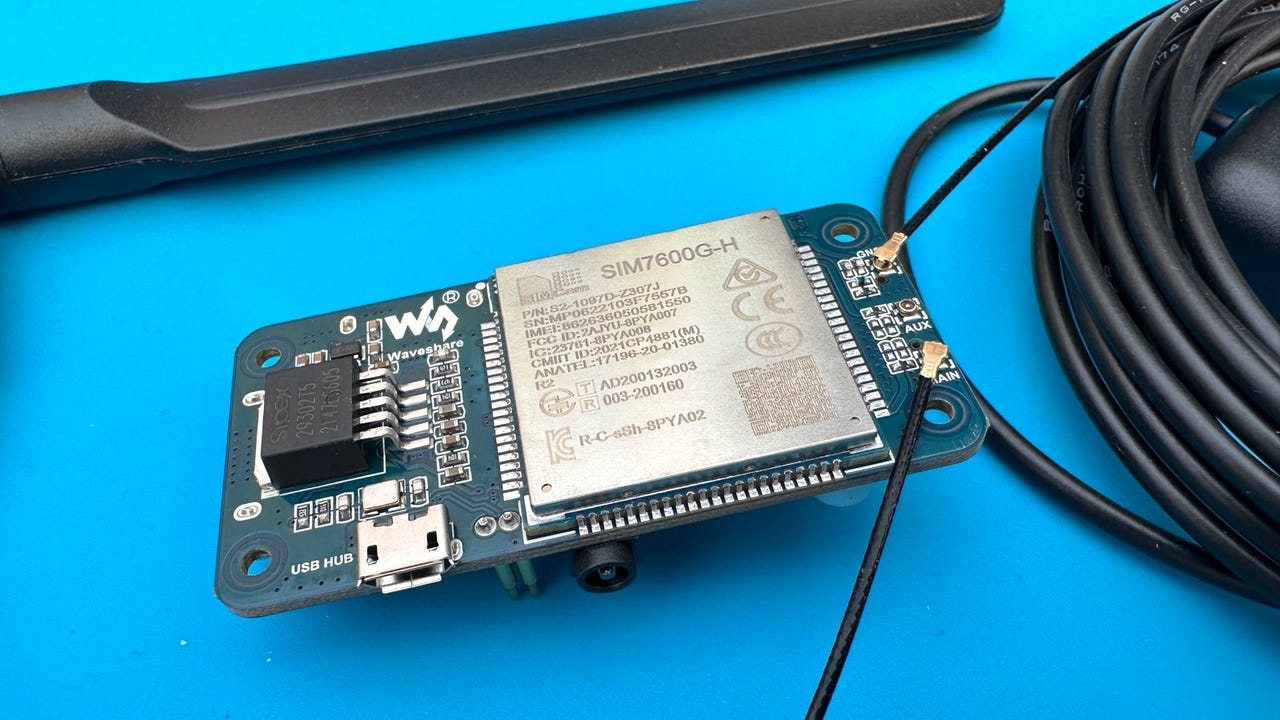Run your Raspberry Pi off-grid with solar power. Here’s what you need

Waveshare SIM7600G-H 4G HAT (B) for Raspberry Pi Supports LTE Cat-4 4G/3G/2G Adrian Kingsley-Hughes/ZDNET
I'm working on an exciting Raspberry Pi project that requires the single-board computer to operate off-grid for a whole week, while efficiently powering the Pi itself, some low-power environmental sensors, and a 4G cellular/GPS module. Size and weight constraints are not major issues (within reasonable limits), so harnessing solar energy seems like the most logical solution.
Initially, I considered connecting a solar panel to a power bank and using that to run the Pi. Although this approach would work, it felt a bit clunky and lacked the reliability necessary for such a demanding project. Moreover, power banks aren't designed to handle solar panel charging effectively due to the fluctuating power from the panel.
Read also: I found the Goldilocks of portable power stations (and it's currently on sale)
To ensure a more professional and reliable solution, I needed something equipped with MPPT (maximum power point tracking) functionality. This feature enables the charge controller to optimize energy collection and storage from variable energy sources, such as a solar panel affected by changing weather conditions.
That's when I discovered the WaveShare Solar Power Manager.
While the one I purchased required three 18650 lithium-ion batteries, I stumbled upon an alternative version with a built-in 10,000mAh lithium-polymer battery pack. This particular device serves as an optimized solar-input power bank that's designed to handle solar charging.
Waveshare Solar Power Manager Adrian Kingsley-Hughes/ZDNET
And for $35, it's an absolute steal.
Determining the required power was an important consideration. A Pi 4 consumes approximately 0.5A of power under average loads, which can increase to 1A under heavy loads. This means that a 10,000mAh battery pack can power a Pi 4 for roughly 10 to 20 hours.
Also: The best Raspberry Pi alternatives (and single-board computers explained)
(For those who are curious about the math, here's how I calculated this. Power bank capacity is measured in mAh [milliamp hours]. So, 10,000mAh is equivalent to 10Ah, meaning the battery pack could sustain a 10A load for about 1 hour or a 1A load for approximately 10 hours. However, real-world efficiency is typically around 80%, so a 10,000mAh power bank would comfortably support a 1A load for at least 8 hours.)
But that power consumption is for the Pi 4 alone, and not the sensors and 4G module that need to be factored in. With that in mind, I chose to go with the much more energy-efficient Pi Zero 2 W.
The Pi Zero 2 W consumes about 0.1A under average loads and can peak at around 0.4A under heavy loads. This means the 10,000mAh lithium-polymer battery pack will provide an even better runtime for the Pi Zero 2 W, and easily handle the additional load of the environmental sensors and the 4G module.
Also: How I solved one of my biggest Raspberry Pi headaches
And don't forget: When the sun is shining, the battery inside the WaveShare Solar Power Manager is continually being topped off.
Now, let's talk about the solar panel.
This is a beefy solar panel, and overkill for this project. Adrian Kingsley-Hughes/ZDNET
Because solar panels come in various shapes, sizes, and price ranges, this is where things can get exciting. Personally, I wanted a solar panel that could continuously recharge the batteries while the Raspberry Pi was running and had the added benefit of being waterproof.
Also: This Raspberry Pi (or other SBC) cooler is better than heatsinks and fans for me
I happened to have an expensive 5V/10W waterproof Voltaic P110 solar panel lying around unused. However, if you're looking for a more cost-effective option, consider a 5V/6W solar panel designed for powering stick up security cameras.
Connecting the solar panel to the solar power manager Adrian Kingsley-Hughes/ZDNET
I have tested this setup and successfully ran a Pi 4 continuously for over a week, solely powered by the late spring sun here in the UK, so, I am confident that it will be more than capable of handling a Pi Zero 2 W equipped with sensors and the 4G module.
It blows my mind just how well this system works.

